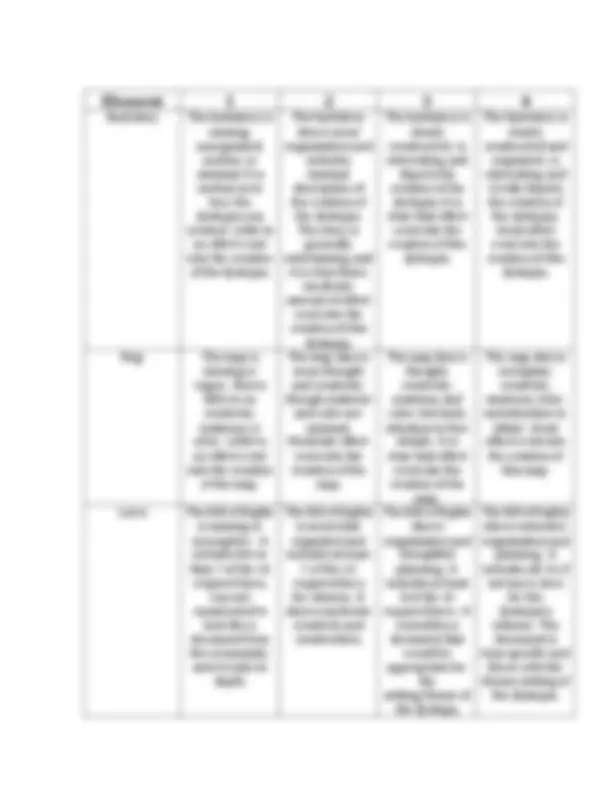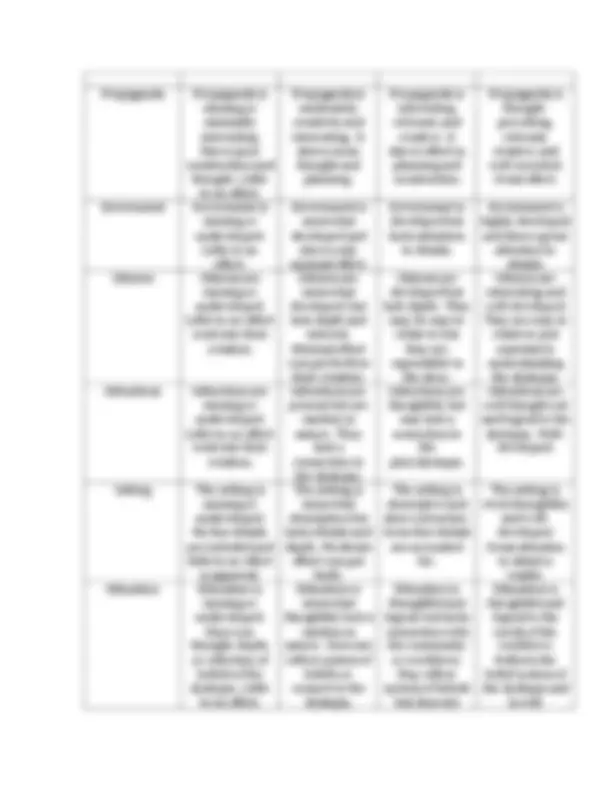





Study with the several resources on Docsity

Earn points by helping other students or get them with a premium plan


Prepare for your exams
Study with the several resources on Docsity

Earn points to download
Earn points by helping other students or get them with a premium plan
Community
Ask the community for help and clear up your study doubts
Discover the best universities in your country according to Docsity users
Free resources
Download our free guides on studying techniques, anxiety management strategies, and thesis advice from Docsity tutors
GOVERNMENT: Describe the government in your dystopia. What kind of government exists? Who is in charge? 6. CITIZEN: Describe the average citizens in your ...
Typology: Lecture notes
1 / 5

This page cannot be seen from the preview
Don't miss anything!




Propaganda Propaganda is missing or minimally interesting. Shows poor construction and thought. Little to no effort. Propaganda is moderately creativity and interesting. It shows some thought and planning. Propaganda is interesting, relevant, and creative. It shows effort in planning and construction. Propaganda is thought-‐ provoking, relevant, creative, and well executed. Great effort. Government Government is missing or undeveloped. Little to no effort. Government is somewhat developed and shows only minimal effort. Government is developed but lacks attention to details. Government is highly developed and shows great attention to details. Citizens Citizens are missing or undeveloped. Little to no effort went into their creation. Citizens are somewhat developed, but lack depth and interest. Minimal effort was put forth in their creation. Citizens are developed but lack depth. They may be easy to relate to but they are expendable to the story. Citizens are interesting and well-‐developed. They are easy to relate to and essential to understanding the dystopia. Infractions Infractions are missing or undeveloped. Little to no effort went into their creation. Infractions are present but are random in nature. They lack a connection to the dystopia. Infractions are thoughtful, but may lack a connection to the plot/dystopia. Infractions are well thought out and logical to the dystopia. Well-‐ developed. Setting The setting is missing or undeveloped. No fine details are included and little to no effort is apparent. The setting is somewhat description but lacks details and depth. Moderate effort was put forth. The setting is descriptive and shows structure. Some fine details are accounted for. The setting is vivid, thoughtful, and well-‐ developed. Great attention to detail is visible. Education Education is missing or undeveloped. Shows no thought, depth, or reflection of beliefs of the dystopia. Little to no effort. Education is somewhat thoughtful, but is random in nature. Does not reflect system of beliefs or connect to the dystopia. Education is thoughtful and logical, but lacks connection with the community or workforce. May reflect system of beliefs but does not Education is thoughtful and logical to the needs of the workforce. Reflects the belief system of the dystopia and is well
play an essential part in the story. connected throughout the community. Healthcare Healthcare is missing or undeveloped. Shows no depth, detail, or connections to dystopia. Healthcare is somewhat developed, but lacks interest and depth. It may appear random and has few connections to the dystopia’s government. Healthcare is developed, interesting, and, at times, logical. Is thoughtful but not necessarily essential to the way the dystopian government works. Healthcare is well-‐developed, interesting, and logical. Provokes thought and discussion, and is essential to understanding the dystopian government. Workforce The workforce is missing or undeveloped. Little to no effort. The workforce lacks clear organization and connections, but is present. The workforce is organized and, at times, connects to the dystopia. The workforce is logical and well connected to the dystopia. Diary The diary entry is missing or undeveloped. It shows little to no effort. The diary entry is present but lacks attention to detail. It is random in placement or in creation. Lacks most of the 6 traits of writing and the author shows little attempt to make the character relatable. The diary entry is time specific and age appropriate to the character. It shows good use of most of the 6 traits but may lack all six. The author does a decent job of helping the character and the reader relate. The diary entry is time specific and age appropriate to the character. It is vivid and shows great attention to detail. The 6 traits of writing are present and the author does a great job of relating the reader to the character. Visual Aid Missing/Little to No Effort Developed but lacks creativity, neatness; does not include all information Developed but lacks attention to details. May be missing some information. Well-‐developed, colorful, creative, neat. Includes all information. Comments: Final Score: ____________________